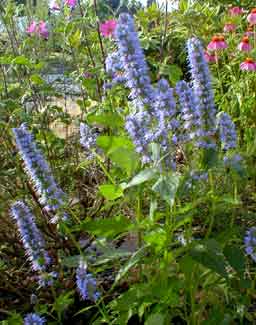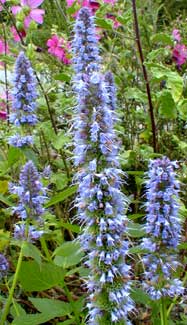
'Blue Fortune' Anise Hyssop
"Here's a pretty sight!" she cried; "that sneak, that blackguard, that old fool, what a way he has to console his friends! I shouldn't wonder if he has committed some piece of barbarity -- given a couple of kicks to this poor child, perhaps; & now I suppose he has gone back to the church to get everything ready to sing the funeral chant, & sprinkle her with hyssop, & bury her out of sight without more ado."
-Juan Valera
(1824‚1905)
"A withered sprig of hyssop was soaking in the holy water bowl."
-Honore de Balzac
(1799-1850)
(1824‚1905)
(1799-1850)
The hybrid hyssop Agastache foeniculum x rugosa 'Blue Fortune' is a handsome low-maintenance clumping perennial which keeps its attractive minty-licorice-scented leaves very fresh & nice even in a xeriscape garden. It was hybridized & developed by Gert Fortgens at the Trompenburg Arboretum, Rotterdam. Tiny bright lavender-blue flowers occur in huge cylyndrical spikes.
 Once it is established, it needs very little watering or attention to thrive & to bloom splendidly over a long period, from July to September if not longer. In the background of the second photo can be seen the pink flowers of the equally long-flowering 'Burgundy Wine' Gay Mallow.
Once it is established, it needs very little watering or attention to thrive & to bloom splendidly over a long period, from July to September if not longer. In the background of the second photo can be seen the pink flowers of the equally long-flowering 'Burgundy Wine' Gay Mallow.At four to six inches long, the bottlebrush flowers are a couple inches longer & quite a bit fatter than our wild-form Agastache rugosa Korean Hyssop, or the chartreuse-leafed cultivar A. foeniculum 'Golden Jubilee.'
A. rugosa has always been one of my favorite sun-garden perennials, & I frankly would not have believed it possible to improve upon it, but 'Blue Fortune' seriously does improve upon something already great & good, & deserved its Great Plant Picks Award for 2004, this award given to plants that are ideal for Northwest gardens.
Of the many flowers that attract honeybees & butterflies, none more excite them than this hyssop, which is perpetually visited by happy pollinators.
The one inch by four inch leaves can be used in garden tea blends. Or a single leaf can be bruised & floated on ice tea for the delicious scent. Flowers & leavews can also be dried for sachets. I've also taken a single young tender leaf to cut up with basil leaves or fresh-picked oregano, as a tiny bit of licorcy-mintiness from the hyssop with other herbs really dresses up a plate of scrambled eggs or fried veggies.
Although a little fertilizer doesn't hurt, it is not necessary, & if fed too often or too rich a fertilizer, it will become floppy & less compact. It it does get too long & weak-stemmed, cut it back to start over.
It blooms fine in a good organic soil without being fertilized, though a small amount of lime if grown in acidic soils might do it some good. More important is never to overwater. It will be glad to have a little water during the longest hot days of summer, but in seasons with even a little rainfall it can be ignored.
'Blue Fortune' is not apt to suffer any diseases, is somewhat deer resistant, does well in full sun or bright shade, & grows to two feet tall for the leaves, another foot for the flower stems. Overlarge clumps can be divided every few years in spring.